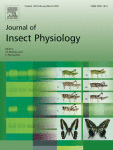Ver ítem
- xmlui.general.dspace_homeCentros e Institutos de InvestigaciónCICVyA. Centro de Investigación en Ciencias Veterinarias y AgronómicasInstituto de GenéticaArtículos científicosxmlui.ArtifactBrowser.ItemViewer.trail
- Inicio
- Centros e Institutos de Investigación
- CICVyA. Centro de Investigación en Ciencias Veterinarias y Agronómicas
- Instituto de Genética
- Artículos científicos
- Ver ítem
Mating-induced changes in responses of female Queensland fruit fly to male pheromones and fruit : a mechanism for mating-induced sexual inhibition
Resumen
In order to reproduce, female tephritid fruit flies need both mates for fertilization and fruit for oviposition. Virgin females are prone to mating and approach males, attracted by their pheromones. Mated females, however, may experience an abrupt reduction of mating propensity and prioritise the search for suitable fruit rather than additional mates. Accordingly, mating in fruit flies may induce a switch in olfactory preferences of females from
[ver mas...]
In order to reproduce, female tephritid fruit flies need both mates for fertilization and fruit for oviposition. Virgin females are prone to mating and approach males, attracted by their pheromones. Mated females, however, may experience an abrupt reduction of mating propensity and prioritise the search for suitable fruit rather than additional mates. Accordingly, mating in fruit flies may induce a switch in olfactory preferences of females from pheromones to fruit stimuli, and this switch may also be an important mediator of mating-induced sexual inhibition. To test for mating-induced switches in olfactory preference of female Queensland fruit fly, Bactrocera tryoni, we used wind tunnel assays to assess attraction of mated and virgin females to (1) male sex pheromone delivered through a perforated glass sphere or (2) an entire fruit. Electroantennogram (EAG) responses were also used to test for mating-induced changes in olfactory sensitivity to pheromones and fruit odours. Pheromones elicited quicker upwind responses in virgin females than in mated females; during the first six minutes of trials more virgin females than mated females were observed in the upwind end of the wind tunnel where pheromone odours were released. Fruit cues, in contrast, elicited stronger association with the upwind end of the wind tunnel in mated females than in virgin females from the fifth minute onwards. Also, mated females were observed on the fruit for longer periods than virgin females. EAG responses to pheromones and fruit odours were similar in virgin and mated females, indicating that changes in preferences are not a consequence of changes in peripheral sensitivity of antennae to odours but instead appear to be mediated by post-receptor processing. Our results show that mating reduces attraction to male-produced pheromones and increases attraction to fruit stimuli in B. tryoni females. We propose that this behavioural switch from mating stimuli to oviposition stimuli is an important mediator of mating-induced sexual inhibition in this species.
[Cerrar]

Autor
Devescovi, Francisco;
Hurtado, Juan;
Taylor, Phillip W.;
Fuente
Journal of Insect Physiology 129 : 104195 (Marzo 2021)
Fecha
2021-03
Editorial
Elsevier
ISSN
1879-1611
Formato
pdf
Tipo de documento
artículo
Palabras Claves
Derechos de acceso
Restringido
 Excepto donde se diga explicitamente, este item se publica bajo la siguiente descripción: Creative Commons Attribution-NonCommercial-ShareAlike 2.5 Unported (CC BY-NC-SA 2.5)
Excepto donde se diga explicitamente, este item se publica bajo la siguiente descripción: Creative Commons Attribution-NonCommercial-ShareAlike 2.5 Unported (CC BY-NC-SA 2.5)

